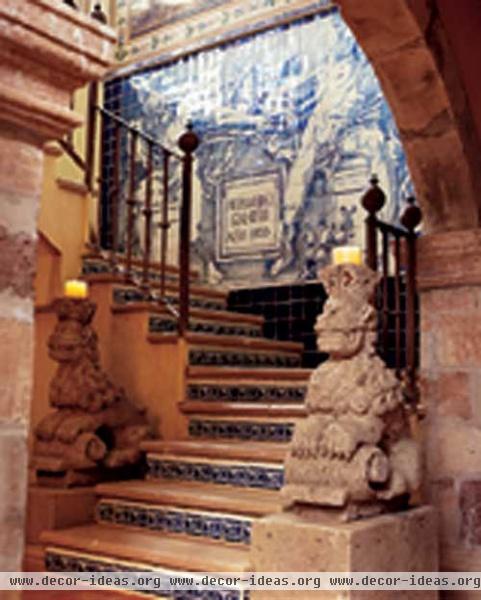HOLY MARY OF THE PRICKLY PEAR(2)

HOLY MARY OF THE PRICKLY PEAR
The courtyard not only is vital for sensible traffic flow but is the focal point of every room. Through wide doorways, rooms open up to its sensory delights: the lulling riffs that flow from its carved cantera (volcanic) stone fountain; the fragrance and color of its jasmine, apple, and fig blossoms, roses, lantana, impatiens, and bougainvillea; and the weathered sheen of its unglazed terra-cotta pavers (called barro perón) that have hosted generations of Hernández family footfalls.
The downstairs includes the chapel, several bedrooms and baths, the formal dining room and parlor, and a main kitchen as well as an "outdoor" kitchen. The outdoor kitchen , one of the hacienda's loveliest and most colorful rooms, features a grill at one end for making carne asada (grilled beef) and a domed oven at the opposite end for baking gorditos (little corn cakes). The sink is made of glazed tiles decorated in the traditional Talavera style. (Talavera- Mexico's majolica-is glazed pottery made from the clays of Puebla). A tiled relief above the doorway also displays the shiny, muted patterns of old Talavera platters.
Tile stairs bracketed with a wrought-iron stair rail lead from the entry to the upstairs gallery-a museum of fine antiques and art that serves as a gathering place for the three second-floor en suite bedrooms and baths adjacent to it. Along one wall of the staircase is a grand vintage tile mural. "It is an allegory in remembrance of my great-great-grandfather, José Antonio Hernández Gamiño, who lived from 1785 to 1855," notes Alfonso. A pair of antique stained-glass French doors create a light tower at the top of the staircase, drenching objects d'art in lavish color. Many of the antiques are heirlooms. But many more are the result of 35 years of collecting by Alicia and Alfonso, who own a fine antiques gallery in Guadalajara, where the couple live full-time in a palatial antique home. (The hacienda is about a two-hour drive away, on rough roads under construction.)
"My father is responsible for how the hacienda looks today-for its decorating," says Ignacio. A painter in his free time, Alfonso composes rooms the way he does canvases, paying attention to color, scale, shape, and balance. Although the hacienda's formal rooms host the most precious antiques, the open-air spaces receive just as much design attention. Furnished with a mix of casual pine and stitched leather, the terraces, pergolas, and patios sport the look most often identified with Mexican design.
URL: HOLY MARY OF THE PRICKLY PEAR(2) http://decor-ideas.org/cases-view-id-1230_2.html











